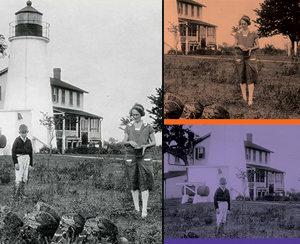Turkey Point Lighthouse History
Built in 1833, Turkey Point Lighthouse sits on a 100 foot high bluff that overlooks the union of the Elk River and the Chesapeake Bay. At 129 feet above the water, Turkey Point Lighthouse is the third tallest light on the bay after the lighthouses at Cape Charles (191 feet) and Cape Henry (164 feet) at the mouth of the Chesapeake Bay in Virginia.
- Turkey Point Lighthouse was built and modeled after Concord Point Lighthouse, which is located across the Chesapeake Bay at the mouth of the Susquehanna River in Havre de Grace. Both lighthouses were built by John Donahoo, however, Turkey Point is brick and Concord Point is granite.
- The lighthouse was very important for mariners as it marked the shipping channel’s change in course from the Chesapeake Bay east to the Elk River, and eventually to the Chesapeake & Delaware (C&D) Canal.
 Eleven wicks and reflectors were used for illumination, until 1855 when a Fourth Order Fresnel Lens with a single lamp was imported from France and installed. The lighthouse was electrified in 1943, at which time a 100 watt bulb, in combination with the lens, produced 680 candlepower of light.
Eleven wicks and reflectors were used for illumination, until 1855 when a Fourth Order Fresnel Lens with a single lamp was imported from France and installed. The lighthouse was electrified in 1943, at which time a 100 watt bulb, in combination with the lens, produced 680 candlepower of light.- In 1948, Fannie Mae Salter retired, making her the last lighthouse keeper of Turkey Point and the last female lighthouse keeper on the Chesapeake Bay. Turkey Point holds the distinction of having more female keepers (four) than any other lighthouse on the Chesapeake Bay. See Ladies of Light: Chesapeake lighthouses and the women who kept them.
- In 2000, the Turkey Point Lighthouse was decommissioned and the maintenance of the structure was taken over by the non-profit organization Turkey Point Light Station (TPLS) Inc.
- On December 2, 2002, Turkey Point Light Station was added to the National Register of Historic Places.
- In 2006, ownership of the lighthouse was transferred to Maryland Department of Natural Resources from the Federal Government.